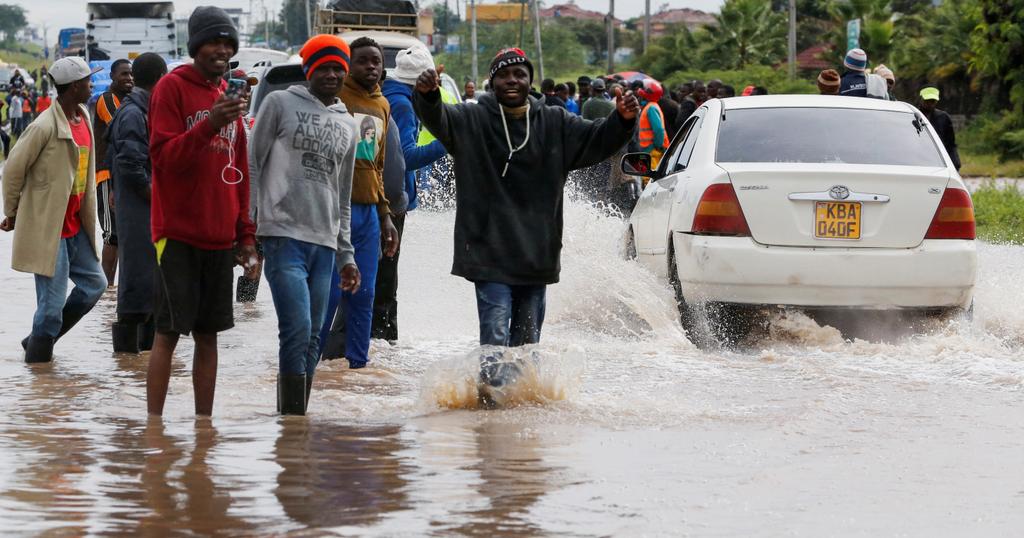Is there a secret to longevity? This health expert says 1,000% yes
In the era of social media, post-COVID, and with mental health at the forefront, a shift is taking […]

April 2024 marked the beginning of difficult days for Kenyans after floods hit the country.
The East African country usually experiences the annual rainy season between March and May every year but this year’s rains have wreaked havoc on the entire nation.
Approximately 37 of 47 counties in the country have been affected by the rains, according to the World Health Organisation (WHO).
Many have been left homeless and several others reported dead from the floods, raising serious concerns from citizens and humanitarian groups globally.
Here is a chronological compilation of events that have happened in Kenya since April.
March rains
Rains that began in March affected many counties in Kenya including the Nairobi, Kirinyaga, Kiambu, Garissa, and the Baringo counties. The rains affected schools and major roads. On 17 April, the Ministry of Interior and National Administration had warned that River Tana was likely to burst its banks and cause flooding in Garissa, Tana River, and Lamu counties after filling up the Seven-Forks dams, including Masinga Dam, which was already overflowing. In other areas, there were landslides recorded.
32 deaths recorded by April 18
By April 18, the United Nations Office for the Coordination of Humanitarian Affairs (UN OCHA)’s review of flash floods in Kenya indicated that at least 32 persons had died with 15 injuries and two missing persons recorded. An estimated 103,485 people (20,697 households) had been affected by the rains, out of which 40, 265 persons had been displaced in 21 out of 47 counties. Over 960 livestock had been killed and 24,010 acres of croplands had been destroyed.

Major dam bursts
The situation was exacerbated on April 29 after a major dam, the Old Kijabe Dam, located in the Mai Mahiu area of the Great Rift Valley region, burst amid torrential rainfall. The dam in the north-western Nakuru county resulted in at least 71 deaths and 110 injuries. Vehicles were seen overturned and being swept away together with uprooted trees and homes.
Toll reaches over 200 by May
According to the UN Office for the Coordination of Humanitarian Affairs (OCHA) at least 210 people had died by May 3, 164 had been injured and 72 were still missing. In addition, more than 205,000 people were reportedly affected by the rains while over 40 thousand households were displaced according to figures from the interior ministry. By May 5, the numbers had reached 228, the interior ministry said.
Rivers overflow their banks
Water sources including Rivers Tana, Athi, and Mara have overflowed their banks, worsening the flooding situation. The Talek River has also been affected.

Health facilities closed
The heavy rains have cut off access to health facilities in some areas, The Star reports. The Ministry of Health has since activated the National Public Health Emergency Operations Centre (PHEOC) in various parts of the country while urging other counties to activate their emergency operation centres for response efforts.
Tourists rescued from flooded camps
On May 1, the Kenya Red Cross announced a rescue operation was embarked on to save trapped tourists affected by the flood waters in over 14 tourist camps in Talek, and Narok after the Talek River broke its banks. Tourists were rescued by air and aqua rescue teams after camps and tents were swept away at the Maasai Mara camp.
Relief and rescue efforts
Rescue efforts are underway to search for persons affected and killed by the floods in the country. Rescue teams are deployed in various parts of the country to search for victims while the Kenya Red Cross Society helps with the provision of first aid among other health intervention assistance.
According to the Interior Ministry, the government has set up more than 100 camps across the country to provide shelter for some 62,000 persons displaced and evacuated with plans to increase the numbers. There are also government efforts to distribute food and other essential supplies.
Amidst the disaster, the Government of Kenya, through the Kenya Disaster Emergency Operations Centre is gathering information from the 33 affected counties for analysis and decision making. The National Public Health Emergency Operations Centre is leading the health situation and response, supported by the World Health Organization (WHO) and other partners including the Kenya Red Cross Society, AMREF, FHI360 and Foundation for Professional Development.
The Ministry of Health has also set up an incident management system team for surveillance, case management, laboratory, logistics risk communication and community engagement to monitor and manage disease outbreaks. Medical camps have been set up with the support of the Red Cross where health services are being rendered to persons affected by the closure of health facilities in the country. According to WHO, over 720 first responders, trained by WHO, are being deployed or on standby for deployment to deal with the situation.
Presidential response
The President William Samoei Ruto has since been touring some areas including the Mathare Depot area to assess flooding in the area. He has pledged support to all persons affected by the crisis. In a post on X, the president pledged food and bedding as well as shelter for affected persons. He also pledged KSh1 billion (7.6 million dollars) towards the rebuilding of schools for affected students. President William Ruto also set May 10 as a mourning day for victims who have died in the floods. The day was observed by national tree planting activities to help mitigate the effects of climate change.

Weather warnings
The Kenya Meteorological Department has issued warnings, saying the rains will persist until the end of May.
Cholera outbreak
Dozens of cholera cases have been reported amidst the floods. According to WHO, 44 cases of the disease has been reported in the Tana River County alone. The outbreak is as a result of destroyed sanitation facilities resulting in the flow of waste water from latrines. Other factors like inadequate sanitation, limited water and untreated water is highlighted as contributing factors. The WHO has meanwhile procured around 87 cholera, 58 interagency and 20 pneumonia kits that are being distributed to key counties and can treat around 10,000 affected people.
Flooding in other East African countries
Some of Kenya’s neighbours have also experienced flooding in recent times. In Tanzania, hundreds have died from the floods and hundreds of thousands have had to flee their homes in Burundi.
East Africa was hit by record floods during the last rainy season in late 2023. Scientists say climate change is causing more intense and frequent extreme weather events.

In the era of social media, post-COVID, and with mental health at the forefront, a shift is taking […]

With its fast speeds and revolutionary potential, 5G stands out as a noteworthy milestone in the field of […]